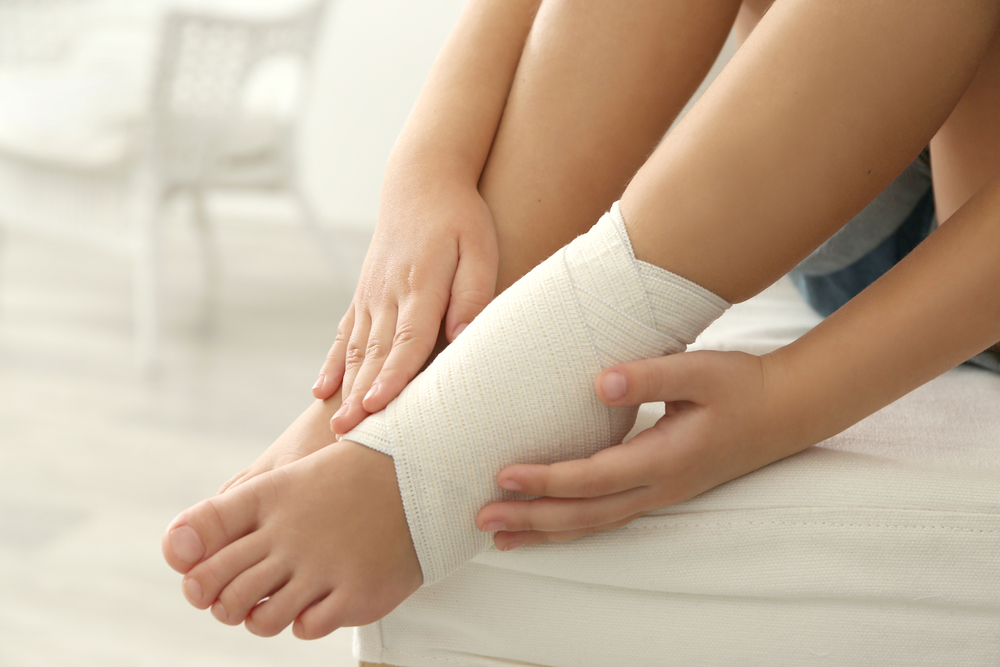Items filtered by date: September 2021
Understanding Heel Bursitis
 Heel pain is one of the most common reasons people visit a podiatrist, and it can make daily activities like work and exercise almost impossible. One source of heel pain is heel bursitis. This can occur when either the bursa sac of fluid that attaches the Achilles tendon and the calcaneal tendon becomes inflamed (known as retrocalcaneal bursitis), or the padding under the heel begins to degenerate because of trauma (known as subcutaneous calcaneal bursitis). Heel pain can have a variety of causes and can affect anyone. If you are struggling with heel pain, consulting with a podiatrist can be extremely beneficial. A podiatrist will be able to properly diagnose and treat the source of the pain.
Heel pain is one of the most common reasons people visit a podiatrist, and it can make daily activities like work and exercise almost impossible. One source of heel pain is heel bursitis. This can occur when either the bursa sac of fluid that attaches the Achilles tendon and the calcaneal tendon becomes inflamed (known as retrocalcaneal bursitis), or the padding under the heel begins to degenerate because of trauma (known as subcutaneous calcaneal bursitis). Heel pain can have a variety of causes and can affect anyone. If you are struggling with heel pain, consulting with a podiatrist can be extremely beneficial. A podiatrist will be able to properly diagnose and treat the source of the pain.
Many people suffer from bouts of heel pain. For more information, contact Elliot T. Udell, DPM of New York. Our doctor can provide the care you need to keep you pain-free and on your feet.
Causes of Heel Pain
Heel pain is often associated with plantar fasciitis. The plantar fascia is a band of tissues that extends along the bottom of the foot. A rip or tear in this ligament can cause inflammation of the tissue.
Achilles tendonitis is another cause of heel pain. Inflammation of the Achilles tendon will cause pain from fractures and muscle tearing. Lack of flexibility is also another symptom.
Heel spurs are another cause of pain. When the tissues of the plantar fascia undergo a great deal of stress, it can lead to ligament separation from the heel bone, causing heel spurs.
Why Might Heel Pain Occur?
- Wearing ill-fitting shoes
- Wearing non-supportive shoes
- Weight change
- Excessive running
Treatments
Heel pain should be treated as soon as possible for immediate results. Keeping your feet in a stress-free environment will help. If you suffer from Achilles tendonitis or plantar fasciitis, applying ice will reduce the swelling. Stretching before an exercise like running will help the muscles. Using all these tips will help make heel pain a condition of the past.
If you have any questions please contact our office located in Hicksville, NY . We offer the newest diagnostic and treatment technologies for all your foot and ankle needs.
Why Are My Toenails Thick?
Thickened toenails are typically a sign of a fungal toenail infection, which can cause changes in the texture and color of the toenail. An infected toenail can often thicken, become brittle or crumbly, and develop white, yellow, or brown discoloration. But while fungal infections are the most common cause of thickened toenails, they are not the only cause. Psoriasis, a skin condition, can also affect the toenails, making them thicker, pitted, and discolored. Paronychia, a nail disease caused by a bacterial infection, can thicken the toenail, make it discolored, and cause redness, pain, and inflammation around the nail. Diabetes can cause toenails to thicken because not enough nutrients are reaching the toenails to maintain their health. Other reasons your toenails may be thickened include onychogryphosis (Ram’s Horn), aging, a toenail injury, or a rare condition called yellow nail syndrome. If you notice changes in the thickness, color, or shape of your toenails, it is suggested that you schedule an appointment with a podiatrist.
If left untreated, toenail fungus may spread to other toenails, skin, or even fingernails. If you suspect you have toenail fungus it is important to seek treatment right away. For more information about treatment, contact Elliot T. Udell, DPM of New York. Our doctor can provide the care you need to keep you pain-free and on your feet.
Symptoms
- Warped or oddly shaped nails
- Yellowish nails
- Loose/separated nail
- Buildup of bits and pieces of nail fragments under the nail
- Brittle, broken, thickened nail
Treatment
If self-care strategies and over-the-counter medications does not help your fungus, your podiatrist may give you a prescription drug instead. Even if you find relief from your toenail fungus symptoms, you may experience a repeat infection in the future.
Prevention
In order to prevent getting toenail fungus in the future, you should always make sure to wash your feet with soap and water. After washing, it is important to dry your feet thoroughly especially in between the toes. When trimming your toenails, be sure to trim straight across instead of in a rounded shape. It is crucial not to cover up discolored nails with nail polish because that will prevent your nail from being able to “breathe”.
In some cases, surgical procedure may be needed to remove the toenail fungus. Consult with your podiatrist about the best treatment options for your case of toenail fungus.
If you have any questions, please feel free to contact our office located in Hicksville, NY . We offer the newest diagnostic and treatment technologies for all your foot care needs.
What Is Blue Toe Syndrome?
Blue toe syndrome is a condition in which one or more toes develop a lace-like, bluish-purple discoloration (livedo reticularis) due to a blockage of the small blood vessels in the foot. In addition to skin discoloration, blue toe syndrome can cause intense pain in the foot that may radiate higher up into the leg. This condition is often associated with older age and other conditions that affect blood flow, such as atherosclerosis. Left untreated, blue toe syndrome can lead to skin ulceration, tissue death, and even gangrene. If you notice a sudden bluish-purple discoloration in your toes, it is suggested that you seek the care of a podiatrist as soon as possible.
While poor circulation itself isn’t a condition; it is a symptom of another underlying health condition you may have. If you have any concerns with poor circulation in your feet contact Elliot T. Udell, DPM of New York. Our doctor will treat your foot and ankle needs.
Poor Circulation in the Feet
Peripheral artery disease (PAD) can potentially lead to poor circulation in the lower extremities. PAD is a condition that causes the blood vessels and arteries to narrow. In a linked condition called atherosclerosis, the arteries stiffen up due to a buildup of plaque in the arteries and blood vessels. These two conditions can cause a decrease in the amount of blood that flows to your extremities, therefore resulting in pain.
Symptoms
Some of the most common symptoms of poor circulation are:
- Numbness
- Tingling
- Throbbing or stinging pain in limbs
- Pain
- Muscle Cramps
Treatment for poor circulation often depends on the underlying condition that causes it. Methods for treatment may include insulin for diabetes, special exercise programs, surgery for varicose veins, or compression socks for swollen legs.
As always, see a podiatrist as he or she will assist in finding a regimen that suits you. A podiatrist can also prescribe you any needed medication.
If you have any questions, please feel free to contact our office located in Hicksville, NY . We offer the newest diagnostic and treatment technologies for all your foot care needs.
What Types of Exercises Should I Do for a Sprained Ankle?
Following an ankle sprain, doing gentle ankle exercises can be beneficial, although you should first get your doctor’s approval. Ankle exercises are great for ankle sprain recovery because they can improve your ankle’s range of motion, strength, stability, and flexibility, which can promote healing and help prevent future injuries. One simple exercise that you can do to improve your ankle’s range of motion is the “ankle alphabet.” Sit on a chair or couch with your leg extended out in front of you. Trace the letters of the alphabet, from A to Z, in the air using your big toe. Repeat this exercise two to three times. To learn more about the benefits of ankle exercises for ankle sprain recovery, please consult with a podiatrist.
Ankle sprains are common but need immediate attention. If you need your feet checked, contact Elliot T. Udell, DPM from New York. Our doctor can provide the care you need to keep you pain-free and on your feet.
How Does an Ankle Sprain Occur?
Ankle sprains take place when the ligaments in your ankle are torn or stretched beyond their limits. There are multiple ways that the ankle can become injured, including twisting or rolling over onto your ankle, putting undue stress on it, or causing trauma to the ankle itself.
What Are the Symptoms?
- Mild to moderate bruising
- Limited mobility
- Swelling
- Discoloration of the skin (depending on severity)
Preventing a Sprain
- Wearing appropriate shoes for the occasion
- Stretching before exercises and sports
- Knowing your limits
Treatment of a Sprain
Treatment of a sprain depends on the severity. Many times, people are told to rest and remain off their feet completely, while others are given an air cast. If the sprain is very severe, surgery may be required.
If you have suffered an ankle sprain previously, you may want to consider additional support such as a brace and regular exercises to strengthen the ankle.
If you have any questions please feel free to contact our office located in Hicksville, NY . We offer the newest diagnostic and treatment technologies for all your foot and ankle needs.




